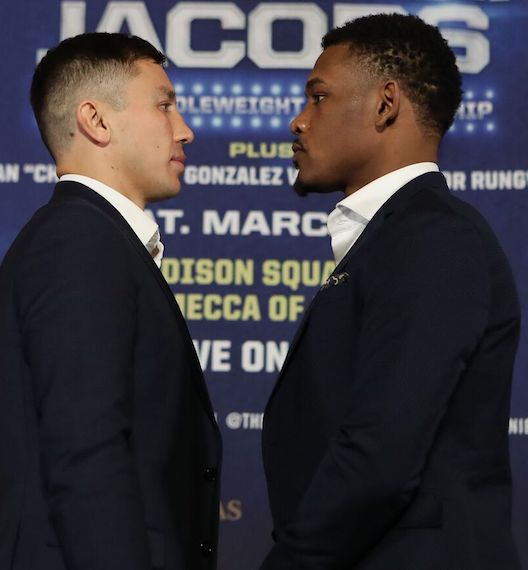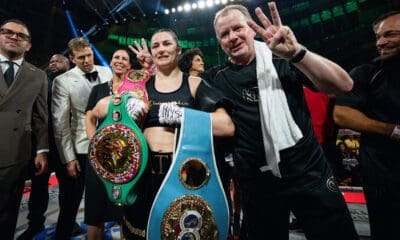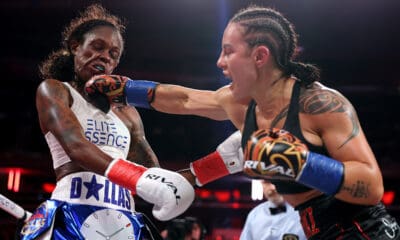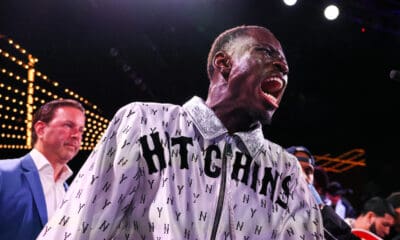Nearly a half-century ago, a 35-year-old Argentinian light-heavyweight named Gregorio Peralta came into Madison Square Garden and took George Foreman into deep water.
Although he was a veteran of nearly 100 pro fights, Peralta was considered harmless enough to match with Foreman, the fearsome young U.S. Olympic heavyweight champion, who was being brought along slowly through his first 15 bouts.
But Peralta did something unexpected that night. He didn’t fold up, the way 13 of Foreman’s previous opponents had. He actually behaved as if he expected to win. And his slick, but not particularly menacing, style so frustrated Foreman that the 21-year-old was so exhausted and discouraged after eight rounds his trainer, Dick Saddler, lied to him and said that the next round was in fact the 10th and final round. (Naturally, Saddler had some explaining to do when Foreman came back after a good 9th round only to learn he had to fight one more.)
Foreman won the fight but Peralta had sent a message, even if the rest of the world was slow to pick it up.
By patiently boxing Foreman, counterpunching him and avoiding his devastating power, he was able to bring Foreman into the late rounds of a pro fight, where it was obvious he was extremely vulnerable.
In short, he had laid out the blueprint for how to beat the seemingly unbeatable, even if he couldn’t quite pull it off himself.
Four years later, Muhammad Ali, who followed no one’s blueprints but his own, shocked the world by exhausting, discouraging and KOing Foreman in Zaire, and three years after that, Jimmy Young, a much lesser fighter, used a similar strategy to beat Foreman and send him in a 10-year retirement.
And that is hardly the only example. A forgotten heavyweight named Bill Brennan laid the groundwork for Jack Dempsey’s 1926 defeat by Gene Tunney in a fight at the Garden five years earlier. Quick Tillis and Mitch (Blood) Green gave previews of Mike Tyson’s defeat at the hands of Buster Douglas. And 10 years before the infamous “No mas’’ fight, Esteban DeJesus showed the world how Roberto Duran could be outboxed and discouraged in a non-title bout while Ray Leonard was still in grade school.
The point is, the seeds for an apparently unbeatable fighter’s first defeat are often planted well in advance, although they are often hard to recognize until after the fact, when they suddenly become glaringly obvious.
Such an example may have been presented right before our eyes six months ago, when English middleweight Kell Brook gave Gennady Golovkin all he could handle for four rounds before falling victim to Golovkin’s relentless assault in round 5.
It is worth reconsidering that match now on the eve of Golovkin’s title unification showdown against Daniel Jacobs Saturday night at Madison Square Garden.
Jacobs, a very good fighter with some significant flaws, may not be capable of completing the job that Brook started. But there is no doubt that Brook left behind a trail of crumbs that Jacobs might very well be planning to follow.
Although Golovkin (36-0, 33 KOs) has never been off his feet as a pro or, he says, as an amateur, Brook hit him solidly and repeatedly with his left hand, thrown more like an uppercut than a hook, and on several occasions followed it up with a straight right. Golovkin took the shots well but there is no dispute that they got his attention. And incidentally, that was the last time Golovkin was in the ring.
When asked at Monday’s news conference if there was any particular Golovkin fight that showed him weaknesses that he could exploit, Jacobs said “Not really.’’
But he acknowledged that Brook did something to Golovkin few if any fighters had done before.
“Brook shook him up, yeah,’’ Jacobs said. “I don’t know if you can say that he hurt him, but he shook him up. And if a welterweight can shake you up, that’s why I’m excited. I know if I land those same shots it might have a different effect.’’
Jacobs went on to point out that Golovkin’s habit of tucking his chin behind his shoulder makes it difficult to hit him cleanly, which is of course another way of saying he can be hit with an uppercut.
The uppercut, particularly with the left hand, has never been a huge weapon in Jacob’s arsenal, but again, there is no dispute that Jacobs can hit with both hands, and he is and always has been a legitimate middleweight.
Clearly, this kind of thinking has not escaped Golovkin’s camp; his trainer, Abel Sanchez, referred specifically to questions about the Brook fight when he said, “I hope (Jacobs) believes what he’s been reading and comes to fight. He has power in both hands but when he’s delivering his power he’s going to be opening himself up.’’
Sanchez also pointed out, “Once they hit (Golovkin), he loses respect for the guy he’s fighting.’’
That is always a danger, that a fighter like Jacobs, who has grown accustomed to seeing opponents crumble under his power, will find his own confidence crumbling if his punches bounce off Golovkin. By the same token, taking Jacobs’ best shot can only further embolden Golovkin, who doesn’t lack for confidence to begin with.
A couple of weeks ago, I asked Golovkin if he could recall the last time he was hurt by a punch. He laughed and shook his head. “I can’t remember,’’ he said. After wracking his memory, he allowed that he might have been hurt on his first day in a boxing gym, when he got his nose bloodied as a 10-year-old.
By any standard, Golovkin is a fearsome fighter, as Foreman was in the 1970 and Tyson was in the 80s. And there are serious questions about Jacobs, particularly because of his KO loss – off a perfect short right – by Dmitry Pirog in 2010, and being dropped in the first round by Sergio Mora in their first bout two years ago. He has a tendency to lunge with his punches, and to get wild when he thinks he has an opponent in trouble, both of which could be fatal against Golovkin.
But he’s certainly unafraid, as anyone who has beaten cancer would be, and he can hit, and he’s smart enough to be able to watch a tape and learn from it.
The tape for him to watch is the Golovkin-Kell Brook fight – 15 minutes that if you’re watching correctly, shows the world how Gennady Golovkin might someday be beaten.
That day may not be Saturday, but the blueprint is out there, and sooner or later, someone is bound to use it.
EDITOR NOTE: Welcome Wallace! This is your stomping ground, the boxing milieu. Baseball is fine, dandy…but the boxing space, that’s where sports and politics and existential queries and the shady and the sublime intersect. Looking forward to you shining your light into the crevices and sharing what you find, on NYFIGHTS.




















